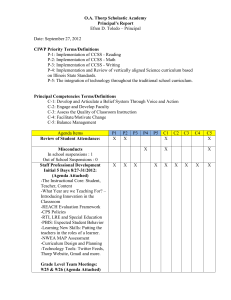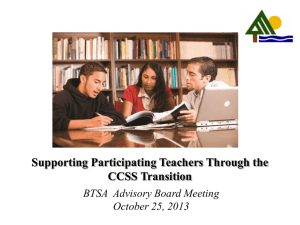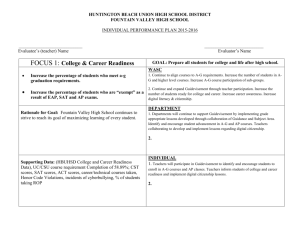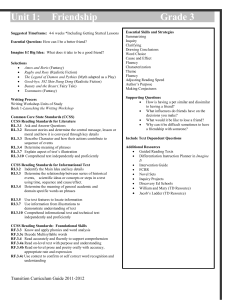2013-14 Tennessee District Strategic Planning Template
advertisement
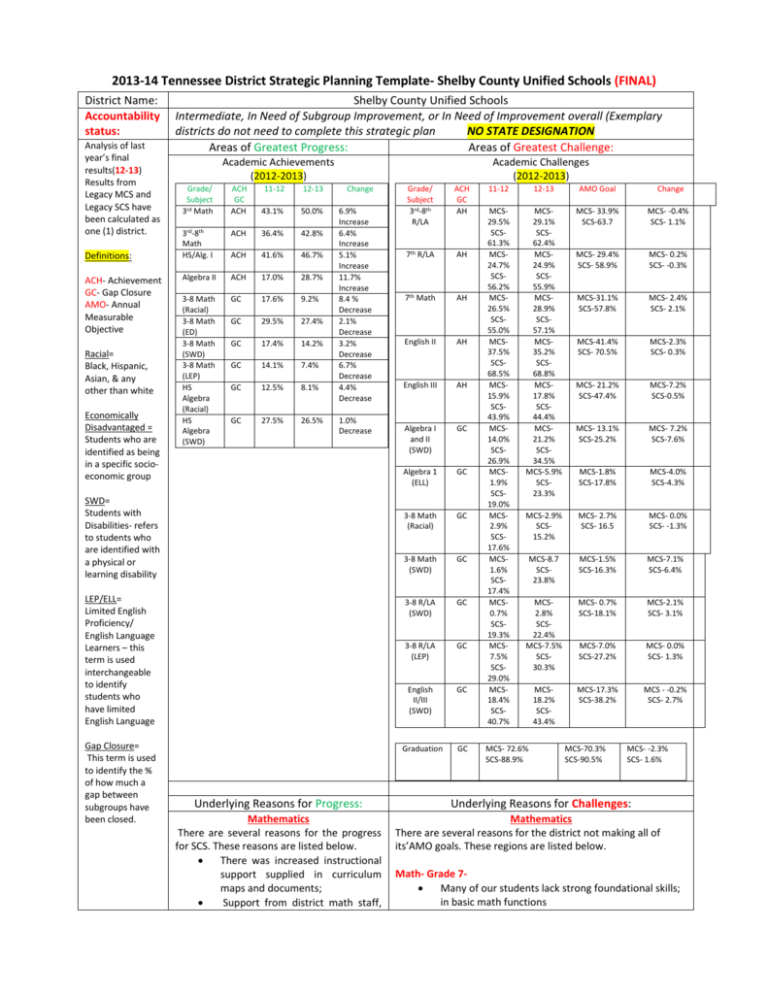
2013-14 Tennessee District Strategic Planning Template- Shelby County Unified Schools (FINAL) District Name: Accountability status: Analysis of last year’s final results(12-13) Results from Legacy MCS and Legacy SCS have been calculated as one (1) district. Shelby County Unified Schools Intermediate, In Need of Subgroup Improvement, or In Need of Improvement overall (Exemplary districts do not need to complete this strategic plan NO STATE DESIGNATION Areas of Greatest Progress: Areas of Greatest Challenge: Academic Achievements (2012-2013) Academic Challenges (2012-2013) Grade/ Subject 3rd-8th R/LA ACH GC AH 7th R/LA AH 7th Math AH English II AH English III AH Algebra I and II (SWD) GC Algebra 1 (ELL) GC 3-8 Math (Racial) GC 3-8 Math (SWD) GC LEP/ELL= Limited English Proficiency/ English Language Learners – this term is used interchangeable to identify students who have limited English Language 3-8 R/LA (SWD) GC 3-8 R/LA (LEP) GC English II/III (SWD) GC Gap Closure= This term is used to identify the % of how much a gap between subgroups have been closed. Graduation GC Definitions: ACH- Achievement GC- Gap Closure AMO- Annual Measurable Objective Racial= Black, Hispanic, Asian, & any other than white Economically Disadvantaged = Students who are identified as being in a specific socioeconomic group Grade/ Subject 3rd Math ACH GC ACH 11-12 12-13 Change 43.1% 50.0% 3rd-8th Math HS/Alg. I ACH 36.4% 42.8% ACH 41.6% 46.7% Algebra II ACH 17.0% 28.7% 3-8 Math (Racial) 3-8 Math (ED) 3-8 Math (SWD) 3-8 Math (LEP) HS Algebra (Racial) HS Algebra (SWD) GC 17.6% 9.2% GC 29.5% 27.4% GC 17.4% 14.2% GC 14.1% 7.4% GC 12.5% 8.1% 6.9% Increase 6.4% Increase 5.1% Increase 11.7% Increase 8.4 % Decrease 2.1% Decrease 3.2% Decrease 6.7% Decrease 4.4% Decrease GC 27.5% 26.5% 1.0% Decrease SWD= Students with Disabilities- refers to students who are identified with a physical or learning disability Underlying Reasons for Progress: Mathematics There are several reasons for the progress for SCS. These reasons are listed below. There was increased instructional support supplied in curriculum maps and documents; Support from district math staff, 11-12 12-13 AMO Goal MCS29.5% SCS61.3% MCS24.7% SCS56.2% MCS26.5% SCS55.0% MCS37.5% SCS68.5% MCS15.9% SCS43.9% MCS14.0% SCS26.9% MCS1.9% SCS19.0% MCS2.9% SCS17.6% MCS1.6% SCS17.4% MCS0.7% SCS19.3% MCS7.5% SCS29.0% MCS18.4% SCS40.7% MCS29.1% SCS62.4% MCS24.9% SCS55.9% MCS28.9% SCS57.1% MCS35.2% SCS68.8% MCS17.8% SCS44.4% MCS21.2% SCS34.5% MCS-5.9% SCS23.3% MCS- 33.9% SCS-63.7 MCS- -0.4% SCS- 1.1% MCS- 29.4% SCS- 58.9% MCS- 0.2% SCS- -0.3% MCS-31.1% SCS-57.8% MCS- 2.4% SCS- 2.1% MCS-41.4% SCS- 70.5% MCS-2.3% SCS- 0.3% MCS- 21.2% SCS-47.4% MCS-7.2% SCS-0.5% MCS- 13.1% SCS-25.2% MCS- 7.2% SCS-7.6% MCS-1.8% SCS-17.8% MCS-4.0% SCS-4.3% MCS-2.9% SCS15.2% MCS- 2.7% SCS- 16.5 MCS- 0.0% SCS- -1.3% MCS-8.7 SCS23.8% MCS-1.5% SCS-16.3% MCS-7.1% SCS-6.4% MCS2.8% SCS22.4% MCS-7.5% SCS30.3% MCS- 0.7% SCS-18.1% MCS-2.1% SCS- 3.1% MCS-7.0% SCS-27.2% MCS- 0.0% SCS- 1.3% MCS18.2% SCS43.4% MCS-17.3% SCS-38.2% MCS - -0.2% SCS- 2.7% MCS- 72.6% SCS-88.9% MCS-70.3% SCS-90.5% Change MCS- -2.3% SCS- 1.6% Underlying Reasons for Challenges: Mathematics There are several reasons for the district not making all of its’AMO goals. These regions are listed below. Math- Grade 7 Many of our students lack strong foundational skills; in basic math functions coaches and interventionists to better implement strategies and utilize resources, Pre-K- 12; There was a stronger focus on utilization of CCSS Mathematical Practice Standards; Instructional strategies tied to TEM teacher evaluation; There were more consistent use of EPGY Stanford Math/Compass Learning for intervention, enrichment, and instructional support. There was an increase in math achievement in grades 3-8 we attribute this to extensive math tutoring and a focused approach utilizing power standards that have helped teachers teach more math concepts with depth. Our high priority schools also utilized TCAP tutors that focused on mathematics interventions with the lowest performing subgroups. Saturday school was also instituted in many schools that focused on increasing numeracy skills. LEP SWD Progress was made in building capacity to develop academic language for LEP in content-area classrooms, especially in schools with larger LEP/NELB populations. There was inconsistent use of EPGY Stanford Math/ Compass Learning for intervention, enrichment and instructional support. Math Racial/ED Students lack strong foundational reading skills; inconsistent use of EPGY Stanford Math/Compass Learning for intervention, enrichment and instructional support; For many of our students this was the first year of formal testing (Grade 3- TCAP); The instructional shifts in CCSS was not internalized into everyday classroom work; CCSS Mathematical Practice Standards were not fully implemented. Racial/ED Algebra I and II Students lacking strong foundational skills Students not placed in Plus classes for additional time and support; Inconsistent use of EPGY Stanford Math/Compass Learning for intervention, enrichment and instructional support; The instructional shifts from CCSS in instruction has not been internalized into everyday classroom work CCSS Mathematical Practice Standards not fully implemented. For most of the students who are ELL, they are first time Algebra students The engagement strategies of teachers must be inclusive and target specific linguistic needs while engaging the students in Algebraic concepts. Reading and Language Arts The number of SWD students referred for evaluation and qualifying for special education services has decreased as a result of effective implementation of RTI through use of Early Intervening Services funds provided by the Department of Exceptional Children for four years. There was also an increase in the number of students with disabilities enrolled in modified math options. (Algebra 1A and B & Algebra Plus classes) in High Schools. Reading and Language Arts The revised curriculum documents and audits performed to ensure the curriculum was appropriate to guide instruction of rigorous standards. There was a focus on writing to stimulus, which demands a Reading and Language Arts 3-8, Reading and Language Arts Grade 7, English II, English III (LEP & SWD) Some students begin school unprepared to engage with text because of limited pre-requisites and limited academic language therefore presenting a learning gap for students in PreK and the early grades. Some students leave third grade, where reading to learn is the objective, without the needed skill set necessary to read and comprehend rigorous text. Due to inconsistent use of the RTI model, students lost their ability to build their reading stamina through small group instruction and extended opportunity for struggling readers. There were ineffective uses and lack of implementation of the Instructional Maps for each grade level in order to infuse CCSS strategies and techniques into classroom instruction. There was also uneven implementation of the instructional shifts required by CCSS in daily classroom instruction. Many students with disabilities did not receive grade Goals for 201314 school year: Plan for this school year: reading and writing connection. There was an increase in the support for principals, assistant principals and, district teams in implementation of Common Core through monthly training sessions which included follow up school visits from the curriculum team. In Reading and Language ArtsSWD utilized English Plus Classes to help with closing the gap and achievement for students with disabilities. level instruction in a co-teaching environment. SWD lacking strong foundational skills and not placed in Plus classes for additional time and support. Inconsistent use of Transitional Support Classes for LEP led to lost opportunity for additional ESL support for English II and III. Specialized training is needed for teachers and administrators on how to work with ELL. *Note: no need to fill in this box, but please reference your AMO targets (available when you log in at http://www.tn.gov/education/mleaops.shtml under “Accountability Data”) for Achievement and Gap Closure in completing the rest of this document. Key strategies to achieve goals: Strategy A - Reading and Language Arts - Focus all instruction on Common Core State Standards Implementation Plan: •Infusion of rigorous CCSS into all curriculum documents used by teachers with support and follow-up using curriculum audits • Focused instruction on reading complex text closely and writing in relationship to stimulus • Mandatory professional development for all teachers, coaches, mentors, interventionists, and other district professionals who have responsibility for implementation of rigorous CCSS • Continue to implement a tiered reading instructional model (RTI) with specific interventions for K-3 (iStation),and 4-12 grade (Reading Plus, CompassLearning) These programs are available to students during instructional day, in after school programs, and at home where the parents can help Require that all schools have a schedule that allows for weekly intervention time •Collaborate with, after school programs, and other appropriate programs to help ensure students practice new skills and knowledge after school and at home in alignment with CCSS Provide more seat time for students with disabilities in English Plus Classes by ensuring teacher allocations Establish district norm for daily instructional time for beginning level LEP students Focus LEP instruction on the Foundational Skills of CCSS (print concepts/phonological awareness/ phonics and word recognition/fluency) Collaborate with district staff and principals to ensure that high schools include class periods for transitional LEP support classes as companion courses for English II and III Increase the number of students with disabilities receiving instruction in inclusive environments with teachers who are instructing that focuses on content area standards Provide PD for teachers in the use of scaffolding strategies for students beyond their current ability for additional support (use of anchor models, academic language stems, graphic organizers, and visual representations) Desired Outcomes Achievement Gap: Reading/Language Arts 2013 Performance Students Subject Type 2014 MCS SCS UNIFIED AMOs 3-8 RLA Achievement 29.1% 62.4% 39.8% 43.6% Gr 3 RLA Achievement 28.4% 65.9% 39.9% 43.7% Gr 7 RLA Achievement 24.9% 55.9% 35.2% 39.3% HS English II Achievement 35.2% 68.8% 46.2% 49.6% HS English III Achievement 17.8% 44.4% 26.3% 30.9% 3-8 Racial RLA Gap Closure 3.3% 16.7% 10.2% 9.6% HS Racial English Gap Closure 2.7% 14.9% 9.0% 8.4% 3-8 ED RLA Gap Closure 19.0% 30.2% 32.1% 30.1% HS ED English Gap Closure 13.8% 27.5% 26.3% 24.7% 3-8 ELL RLA Gap Closure 7.5% 30.3% 17.2% 16.1% HS ELL English Gap Closure 19.6% 53.5% 26.5% 24.8% 3-8 SWD RLA Gap Closure 2.8% 22.4% 9.7% 9.1% HS SWD English Gap Closure 18.2% 43.4% 26.6% 24.9% Projected costs and funding sources: Common Core Consultant- ( proposed $25,000)- (Fund 1) Teacher stipends ($90,000) (Fund I) Implementation of RTI- Reading Plus, iStation - ($2mil) (Fund 1) CompassLearning- ($156,300) (Fund 1) Strategy B - Math - Focus all instruction on Common Core State Standards Implementation Plan: • Infuse additional resources and rigorous tasks that support CCSS instructional shifts and Constructed Response Assessments (CRA) into Mathematics Curriculum Guides • Provide ongoing support and professional development by district content specialists for administrators, PLC coaches, and teachers including Secondary Math Collaboratives, TNCore videos and instructional resources, PLCs, visits to the district Model Classrooms, and support from TNCore Math Coaches • Establish Mathematics Weebly to share dates and instructional resources such as CRA support, exemplar lessons submitted by teachers, professional learning, access to videos and other information vital to K -12mathematics classrooms •Provide strategies that support CCSS instructional shifts embedded within TEM rubric •Provide instructional leaders with a schedule of professional learning that include videos, research based articles, and relevant topics to utilize during school PLCs •Incorporate high leverage instructional strategies with a specific focus on understanding and implementing the CCSS Mathematical Practices disseminated in all communications with teachers, administrators, and parents, where appropriate Collaborate with, after school programs, and other appropriate programs to help ensure students practice new skills and knowledge after school and at home in alignment with CCSS Require that all schools have a schedule that allows for weekly intervention time Increase the number of students with disabilities receiving instruction in inclusive environments with teachers who are instructing that focuses on content area standards Provide PD for teachers in the use of scaffolding strategies for students beyond their current ability for additional support (use of anchor models, academic language stems, graphic organizers, and visual representations) Provide more seat time for students with disabilities in Math Plus Classes by ensuring teacher allocations Desired Outcomes Achievement Gap-Mathematics 2013 Performance Students Subject Type 2014 MCS SCS UNIFIED AMOs 3-8 Math Achievement 33.0% 63.3% 42.8% 46.4% Gr 3 Math Achievement 39.0% 74.9% 50.0% 53.1% Gr 7 Math Achievement 28.9% 57.1% 38.3% 42.2% HS Algebra I Achievement 37.9% 67.6% 46.7% 50.0% HS Algebra II Achievement 17.4% 51.2% 28.7% 33.2% 3-8 Racial Math Gap Closure 2.9% 15.2% 9.2% 8.6% HS Racial Algebra Gap Closure 2.1% 13.3% 8.1% 7.6% 3-8 ED Math Gap Closure 14.7% 26.0% 27.4% 25.7% HS ED Algebra Gap Closure 6.8% 23.4% 21.9% 20.5% 3-8 ELL Math Gap Closure -0.4% 12.1% 7.4% 6.9% HS ELL Algebra Gap Closure 5.9% 23.3% 12.6% 11.8% 3-8 SWD Math Gap Closure 8.7% 23.8% 14.2% 13.3% HS SWD Algebra Gap Closure 21.2% 34.5% 26.5% 24.8% Projected costs and funding sources: EPGY Stanford Math (Intervention and Enrichment for all students, ($1,660,000 ) (Fund 1 and Title I) Math Science Partnership with the TNDOE (professional learning for K – 5 teacher cohort $259,600) CompassLearning- $156,300 (Fund 1) Key benchmarks for progress on strategies: Benchmark Timeline ELA/Reading 3-8 Revise curriculum documents used by teachers to include all components of CCSS Focus on writing to stimulus and instructional techniques that will connect rigorous text and citing evidence from the text Implement State ELA CCSS Training for teachers and administrators including summer CCSS training and foundational reading skills course Utilize ELA Common Core Coaches to provide classroom instructional support in implementation of CCSS Math 3-8 Racial Expand instructional resources and rigorous tasks that support CCSS instructional shifts and Constructed Response Assessments (CRA) into Mathematics Curriculum Guides Provide CCSS training sponsored by TNDOE for teachers and administrators Utilize common formative assessments to align instruction with student performance July 2013 May 2014 October 2013- May 2014 July 2013 May 2014 August 2013-May 2014 June 2013July 2014 June 2013 August 2013- May 2014 Implement fully the TNDOE Response to Instruction and Intervention including consistent utilization of EPGY Stanford Math and Compass Learning to include universal screening, benchmarking, progress monitoring, rate of improvement, and small group instruction in foundational skills and content tailored to student needs August 2013 -May 2014 Provide ongoing support and professional learning for instructional leaders and teachers utilizing TNCore videos and resources, face –to-face sessions, media sites, outside consultants, PLCs, Model Classrooms, Demonstration Schools and sessions from TNCore Math Coaches June 2013 May 2014 7th Grade Math Expand instructional resources and rigorous tasks that support CCSS instructional shifts and Constructed Response Assessments (CRA) into 7th Grade Mathematics Curriculum Guides Provide CCSS training sponsored by TNDOE for administrators and Grade 7 teachers Utilize common formative assessments in Grade 7 to align instruction with student performance Implement fully the TNDOE Response to Instruction and Intervention including consistent utilization of EPGY Stanford Math and Compass Learning to include universal screening, benchmarking, progress monitoring, rate of improvement, and small group instruction in foundational skills and content tailored to student needs 3-8 Math Achievement Expand instructional resources and rigorous tasks that support CCSS instructional shifts and Constructed Response Assessments (CRA) into Mathematics Curriculum Guide. Provide CCSS training sponsored by TNDOE for teachers and administrators June 2013 July 2013 June 2013 August 2013- May 2014 August 2013- May 2014 June 2013 July 2013 June 2013 Utilize common formative assessments to align instruction with student performance Implement fully the TNDOE Response to Instruction and Intervention including consistent utilization of EPGY Stanford Math and Compass Learning to include universal screening, benchmarking, progress monitoring, rate of improvement, and small group instruction in foundational skills and content tailored to student needs Provide ongoing support and professional learning for instructional leaders and teachers utilizing TNCore videos and resources, face –to-face sessions, media sites, outside consultants, PLCs, Model Classrooms, Demonstration Schools and sessions from TNCore Math Coaches Expand instructional resources and rigorous tasks that support CCSS instructional shifts and Constructed Response Assessments (CRA) into Mathematics Curriculum Guides English II/III Achievement Conduct professional development sessions specific to Common Core strategies that will increase rigor in the English II/III classroom Implement State ELA CCSS training for general ed. teachers and administrators working with ELL that include instructional techniques for struggling readers, ELL and SWD Collaborate with district staff to ensure all high schools include course periods for Transitional ESL support classes as a companion course for English II/III Provide before/afterschool support programs and summer enrichment for ELL Monitor Plus Classes in High School to ensure students with disabilities that are scoring basic and below basic on the EOC are enrolled Algebra I/II Achievement Increase instructional support provided in Algebra I/II curriculum maps and documents with infusion of CCSS content, resources and constructed response tasks Implement TNCore CCSS training for Algebra I/II teachers and administrators Utilize common formative assessments to support instruction in Algebra I/II using Discovery Learning Implement fully the TNDOE Response to Intervention program including consistent utilization of EPGY Stanford Math and Compass Learning to include universal screening, benchmarking, progress monitoring, rate of improvement, and small group instruction in foundational skills for Algebra I/II and content tailored to student needs Continue ongoing support and professional development for administrators and teachers utilizing TNCore videos and resources, local face –to-face sessions, media sites, outside consultants, PLCs, Model Classrooms, Demonstration Schools and sessions from local TNCore Math Coaches Math 3-8 Gap Closure Expand instructional resources and rigorous tasks that support CCSS instructional shifts and Constructed Response Assessments (CRA) into Mathematics Curriculum Guides Provide CCSS training sponsored by TNDOE for teachers and administrators Utilize common formative assessments to align instruction with student performance Implement fully the TNDOE Response to Instruction and Intervention including consistent utilization of EPGY Stanford Math and Compass Learning to include universal screening, benchmarking, progress monitoring, rate of improvement, and small group instruction in foundational skills and content tailored to student needs Provide ongoing support and professional learning for instructional leaders and teachers utilizing TNCore videos and resources, face –to-face sessions, media sites, outside consultants, PLCs, Model Classrooms, Demonstration Schools and sessions from TNCore Math Coaches Expand instructional resources and rigorous tasks that support CCSS instructional shifts and Constructed Response Assessments (CRA) into Mathematics Curriculum Guides 3-8 Reading/Language Arts- Gap Closure Focus all instruction in ELA/Literacy on CCSS by: 1. Revising curriculum documents used by teachers to include all components of CCSS August 2013-May 2014 August 2013-May 2014 June 2013 May 2014 June 2013 July 2013 June 2013 May 2014 June 2013August 2014 August 2013-May 2014 July 2013May 2014 June 2013 July 2013 June 2013 August 2013 May 2014 August 2013-May 2014 June 2013May 2014 June 2013 July 2013 June 2013 August 2013- May 2014 August 2013- May 2014 June 2013 May 2014 June 2013 July 2013 – May 2014 2. Focusing on writing to stimulus and instructional techniques that will connect rigorous text and citing evidence from the text Implement a formative writing assessment aligned to CCSS Implement State ELA CCSS Training for teachers and administrators including summer CCSS training and foundational reading skills course Acquire ELA Common Core Coaches to provide classroom instructional support in implementation of CCSS Implement revised State RTI plan to include focus on 3 tiers of instruction and increase Literacy block to 150 minutes daily in (K-3) and 120 minutes (4-5) Implement fully the TDOE Response to Intervention program with consistent utilization of istation in grades K-3 to include universal screening, benchmarking, progress monitoring and small group instruction in foundational skills for early intervention of reading difficulties tailored to student needs Implement fully Reading Plus (4-12) and CompassLearning ( 3-12) intervention programs in middle and high schools to ensure alignment with RTI model to include universal screening, benchmarking, progress monitoring and rate of improvement for struggling students Continue to provide ongoing support and professional development for administrators and teachers, utilizing TNCore videos and resources, local face-to face sessions, media sites, outside consultants, PLC’s, Demonstration Schools and sessions from TNCore Leadership and ELA CCSS coaches Establish a district wide instructional approach for ESL Literacy Instruction at beginning levels that exceeds compliance minimums Provide before/after school support programs and summer enrichment opportunities for ELL students Collaborate with after school programs to ensure students practice new skills after school and at home in alignment with CCSS English II/III- Gap Closure-LEP Present professional development sessions pertinent to effectively using Academic Vocabulary in the classroom Implement State ELA CCSS training for general Ed. teachers and administrators working with ELL that include instructional techniques for struggling readers, ELL and SWD Collaborate with district staff to ensure all high schools include course periods for Transitional ESL support classes as a companion course for English II Provide before/afterschool support programs and summer enrichment opportunities for ELL Algebra I/II- Gap Closure- SWD Expand instructional resources and rigorous tasks that support CCSS instructional shifts and Constructed Response Assessments (CRA) into Mathematics Curriculum Guides Provide TNCore CCSS training for Algebra I/II teachers and administrators Utilize formative assessments to support instruction in Algebra I using Discovery Ed data result Implement fully the TNDOE Response to Intervention program including consistent utilization of EPGY Stanford Math and Compass Learning to include universal screening, benchmarking, progress monitoring, rate of improvement, and small group instruction in foundational skills for Algebra I/II and content tailored to student needs Continue to provide ongoing support and professional development for administrators and teachers utilizing TNCore videos and resources, local face-to-face sessions, media sites, outside consultants, PLCs, Model Classrooms, Demonstration Schools and sessions from local TNCore Math Coaches Monitor High Schools to ensure students with disabilities scoring below basic enroll in the modified math option classes (i.e. Algebra 1A & 1B, Algebra Plus) Provide extended support for students scoring basic and below basic on formative assessments. (I.e. After school tutoring, Saturday School and learning labs) Graduation Target students or subgroups who are not on track to graduate by providing them with ACT/SAT Workshops, Credit Recovery, career and college readiness counseling, mentoring, July 2013May 2014 July 2013 May 2014 July 2013May 2014 April 2013 May 2014 July 2013ongoing July 2013ongoing July 2013ongoing June 2013ongoing August 2013 – May 2014 August 2013- May 2014 July 2013May 2014 July 2013May 2014 July 2013May 2014 July 2013June 2014 June 2013 August 2013- May 2014 August 2013- May 2014 June 2013May 2014 August 2013- May 2014 August 2013 - May 2014 September 2013 - May and tutoring to raise the level of the importance of graduation Improve communication between parents and schools by increasing the number of phone calls, face-to-face meetings and other general correspondence to parents, so that they will have a better idea of what is expected of their children to stay on track to graduate Implement a formal structure, such as an advisor/advisee program, beginning in 9th grade to ensure each student has at least one adult advocate in the school that supports the student’s educational experience Expand alternative pathways to high school graduation for overage and under-credited, students Train essential school personnel (enrollment and records secretary and counselors) on monitoring the graduation cohort via utilization of the reports posted on TDOE’s secured graduation portal Increase the number of students who are enrolled in Dual Enrollment classes, honors, AP and IB by holding open houses and other recruiting events at the schools Increase the number of students utilizing Memphis Virtual School to meet graduation requirements Continue the implementation of the Latino Student Success Collaboration at selected high schools Implement a Summer Bridge Program to help students and parents with understanding high school structure and graduation requirements 2014 September 2013- May 2014 September 2013 -May 2014 August 2013 -July 2014 Yearly September and March July 2013July 2014 July 2013January 2014 August 2013 – May 2014 February 2013-June 2014
